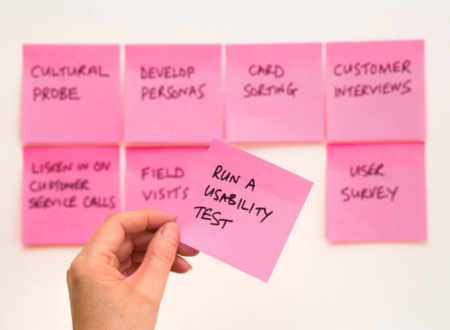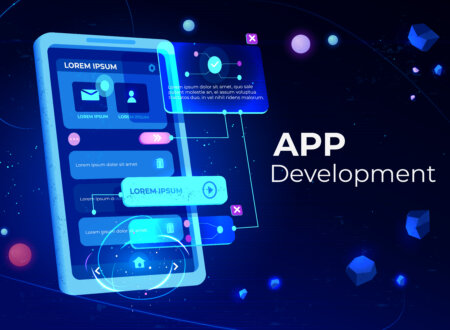The Latest Innovations in Healthcare Mobile App Development

Thanks to increasing healthcare costs and the wide availability of devices like smartphones, smartwatches and different IoT sensors, demand for digital care is rapidly on the rise. Through healthcare mobile app development, innovators were able to greatly increase cost-efficiency of healthcare service delivery, and help answer this growing demand.
However, there is still much to be done, and plenty of room for new innovation. According to Grand View Research, the global home healthcare market size was valued at USD 281.8 billion in 2019, and is expected to have an average growth rate of 7.9% over the next decade.

Source: grandviewresearch.com
A rapidly growing population forces governments to constantly expand public health care systems. This means that healthcare expenses will also continuously increase throughout the foreseeable future.
In order to make health services more accessible to patients everywhere, innovators must find a way to make them more scalable and less fixed in time and space.
What Are the Factors Accelerating Healthcare Innovation?
According to a 2019 research conducted by Deloitte, the key factors driving innovation in healthcare are:
- Cost pressures on traditional models
- Shift to prevention and well-being
- Consumers’ heightened demand for transparency, convenience, access and personalized products and services
- Consumers’ increased access to and control over personal health care data
Thankfully, new technological advancements make it possible to answer the most pressing challenges in this sector. One of the most effective tools here is data management, which has evolved from just storage to drawing insights. This helps medical professionals make better-informed decisions and increase diagnostic precision.
However, newly emerged security challenges may prolong the innovation process. When it comes to digital health, privacy is one of the most discussed concerns among patients and healthcare professionals as well. Keeping personally identifiable health information safe must be a top priority during every healthcare mobile app development project.
Mobile health requires the use of strong encryption and authentication processes to ensure the security of these data.
Benefits of Mobile Health Apps
- Increased speed and cost-efficiency of delivering healthcare services – With solutions such as video visits or AI-powered chatbots, smaller services like patient diagnostics and check-up visits can be delivered at a larger scale, using much less resources.
- Physicians can access health data from anywhere – Completing health care services becomes much less fixed in time and space, increasing the availability of professionals, regardless of their location.
- They enable predictive and preventive care – Healthcare mobile app development allows providers to gradually switch from reactive care to a more preventive approach. Providing consumers with their own personal health assistant can greatly raise their awareness about potential health risks, monitor their diet, body weight, heart rate, etc.
- Increased precision – With the integration of AI, machine learning and advanced data analytics technologies into healthcare processes, professionals are able to make better-informed decisions and spot irregularities they would’ve likely missed otherwise.
- Healthcare services become easier to scale – Healthcare mobile app development also enables providers to answer the rapidly growing demand from patients through increased service accessibility.
- They can help solve staffing challenges – Staff shortages are a major issue in today’s healthcare systems. Adopting advanced technologies that accelerate decision-making and eliminate routine administrative tasks is another step toward solving this challenge.
Most Significant Areas of Innovation in Healthcare Mobile App Development
1. AI-POWERED CHATBOTS AND DIAGNOSTIC SYSTEMS
These types of applications help physicians determine which disease or condition explains patients’ symptoms and signs. Patients can use these apps themselves without having to set up a doctor’s appointment.
After asking a series of symptom-related questions, the diagnostic app uses great amounts of data from electronic health records (EHR) to compare the new information to other, similar cases and provide a diagnosis. Technologies like Natural Language Processing allow these questions to be read and answered more intuitively, making the whole process feel much more natural for patients.
Of course, using an app doesn’t substitute a full diagnosis provided by an experienced professional using specialized medical equipment. In more severe cases, diagnostic apps usually recommend patients to go see a doctor as soon as possible. Nevertheless, dealing with routine queries using AI-backed messaging and voice systems can help organizations decrease physicians’ workload and realize cost savings.
2. CLOUD COMPUTING SOLUTIONS
Cloud computing is an appealing choice for healthcare organizations trying to build out, run and maintain infrastructure for patient record-keeping needs. Public cloud systems are more suitable for providing generic health information. On the other hand, private cloud systems can be used for more security-sensitive cases, like pharmacy orders, patient bills and physician inquiries.
HIPAA compliance is one of the biggest issues in this environment. Organizations often don’t fully embrace cloud computing because of the strict health information security regulations.
3. BLOCKCHAIN SYSTEMS
Peer-to-peer systems with shared digital ledgers promise great possibilities for healthcare organizations. The increased security, portability and integrity of patient data will make creating, modifying and distributing healthcare information much more efficient. Blockchain technology also allows healthcare providers to always have access to patient health records, through a shared system that is used by everyone, while still complying with HIPAA and GDPR regulations.
4. BIG DATA & PREDICTIVE ANALYTICS
Collecting and storing patient health data has been possible for a decades now. However, analyzing these massive pools of accumulated information and drawing actionable conclusions has proven to be a challenge. More recent advances in data science will allow experts to feed patient information (personal and family medical history, previous test results etc.) into AI-based systems to draw relevant conclusions for their effective treatment.
5. INTERNET OF MEDICAL THINGS (IoMT)
IoMT has emerged as the combination of IoT development and telehealth technologies. It mainly includes wearable devices such as smartwatches, ECG and EKG monitors, smart scales and others. By providing consumers with devices that communicate with each other, and are easy to use, they are able to accurately and consistently monitor their own heart rate, blood pressure, body weight, and other vital health information. The results can also be forwarded to their local physician for further analysis.

6. AUGMENTED REALITY AND VIRTUAL REALITY (AR/VR)
From educating new students to planning procedures, or foster post-surgery improvement for patients, Augmented and Virtual Reality applications show a lot of promise. With their help, professionals are able to place patients in more enhanced and simulated environments without having to use physical therapy. While monitoring these sessions, data can also be gathered to assist therapists in devising customized treatment for each patient.
Also, more focus is being placed on developing so-called Smart Health Communities – groups of public, nonprofit, and commercial organizations – who’s goal is to prevent disease and improve people’s well-being, while operating outside traditional healthcare systems.
To achieve this, they are making use of the previously mentioned innovations in data-fueled technologies like AI, NLP, Internet of Things, AR and VR.
Examples of Successful Healthcare Mobile App Development
AI-POWERED CHATBOTS & DIAGNOSTIC APPS
K Health develops a mobile app that uses AI to deliver personalized primary care for patients faster and cheaper. The company is comprised of doctors and developers who are passionate about using advanced machine learning techniques to turn clinical health data into knowledge that can help patients better manage their health.
- Over $97M raised since 2016
Sensely’s avatar and chatbot-based platforms assist insurance plan members and patients with the insurance services and healthcare resources they need, whenever they need it. The company has developed separate chatbot applications specifically for insurers, employers and pharmacies as well.
- Over $26M raised since 2013
MENTAL HEALTH PLATFORMS
The importance of caring for people’s mental health has gained a lot of attention over the past few decades. Advances in healthcare mobile app development also provided some great tools for online therapy and aiding mental stability. The main goal of innovators in this sector is to provide anonymous, easily accessible and affordable mental care for anyone, anywhere.
Talkspace is an online therapy startup that offers affordable and confidential therapy with a network of professional and licensed therapists. With online messaging therapy, users have access to a licensed, professional therapist, without having to schedule an appointment.
- Over $106M raised since 2014
- Over 1 million users.
Headspace is a digital health platform that provides guided meditation sessions and mindfulness training. The company’s content can be accessed online, or via the Headspace mobile app.
- Over $168M raised since 2014
- Used by more than 8 million people in over 200 countries.
INTERNET OF MEDICAL THINGS (IoMT) PRODUCTS
Fitbit is developing wireless wearable sensors that automatically track data about a person’s activities, such as calories burned, sleep quality, steps and distance.
Their trackers collect activity data automatically while it is worn by the user all day. The collected data is wirelessly uploaded to a website where the wearer can see their data and track their progress toward personal goals. Other than trackers, the company also produces smartwatches, smart scales and other accessories.
- Over $66M raised since 2008
- Reportedly almost 16M devices sold in 2019
CLOUD DATA MANAGEMENT SOLUTIONS
Flatiron Health is a healthcare technology and services company focused on accelerating cancer research and improving patient care. They connect community oncologists, academics, hospitals, life science researchers and regulators on a shared cloud-based platform.
Their platform enables cancer researchers and care providers to learn from the experience of a large number cancer patients.
- Over $313M raised since 2013
AR/VR APPLICATIONS
Oxford VR’s highly immersive VR therapy, provides patients with treatments that are: faster and more effective than traditional therapy sessions, significantly lower cost to health providers and loved by users.
Their focus is on developing clinically validated, cost-effective, user-centered treatments with significant impact on patients, the health system and wider economy.
- Over £13M raised since 2017
Summary
In order to be able to answer the growing demand for accessible and accurate healthcare services, organizations must continue to explore emerging, innovative tools and technologies.
The possibilities offered by the technological advances listed in this article are still only partially explored. Apart from achieving great financial results, innovators also have the opportunity to help improve people’s well-being and quality of life on a global scale.
Utilizing the potential of data science, AI, cloud computing and other emerging technologies is certainly a challenge. This is why we offer our help as development partners to healthcare organizations and HealthTech startups all around the world.
If you have a project in mind, feel free to reach out to us for a free consultation session.



